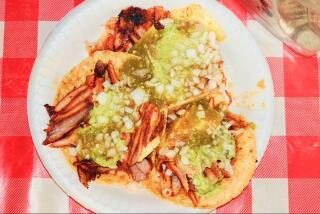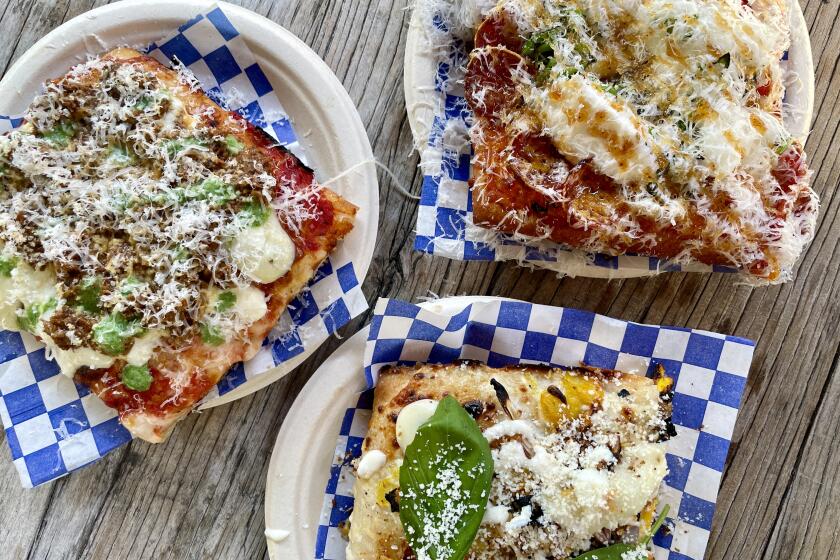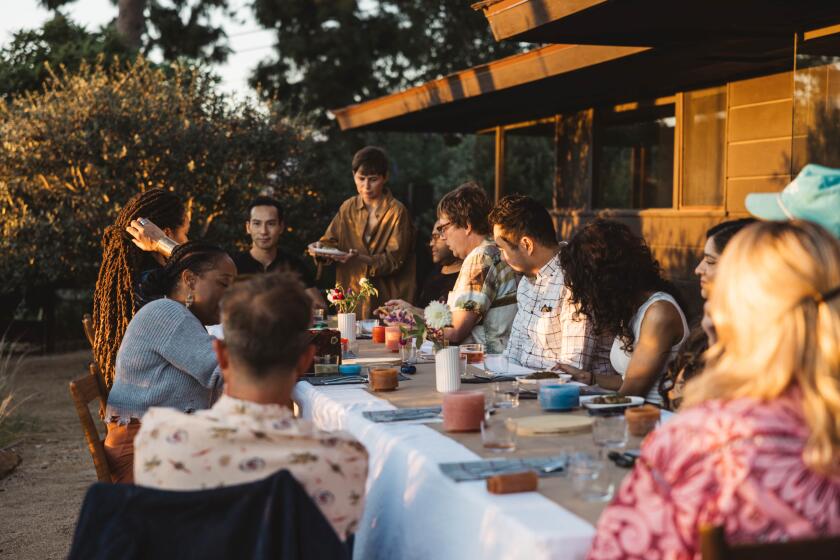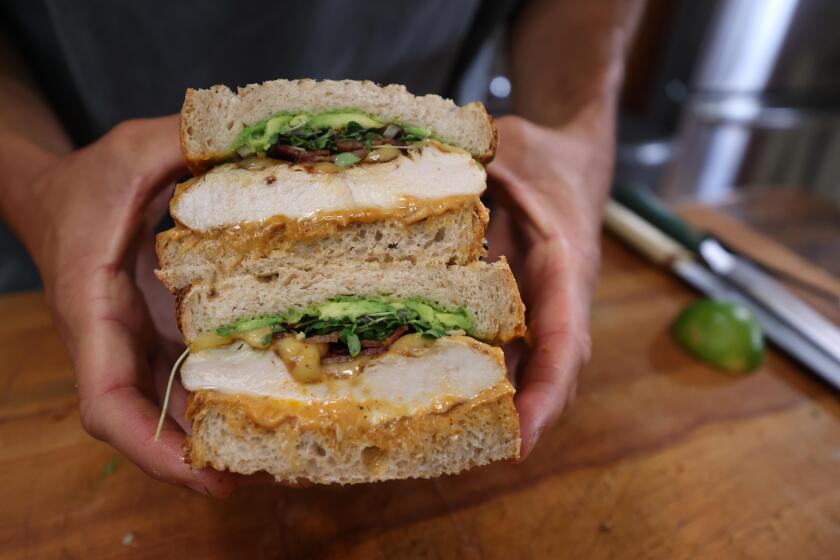Still looking for love in L.A.
New YORK’s Jewish delis are widely regarded as the best in the country. But even my most New York-centric friends will admit that the hand-cut pastrami at Langer’s Deli, just west of downtown Los Angeles, is better than the pastrami at any New York deli. Los Angeles also has great hot dogs, hamburgers and tacos -- and great examples of virtually every Asian cuisine
But we don’t have great pizza.
For the record:
12:00 a.m. May 18, 2005 For The Record
Los Angeles Times Tuesday May 17, 2005 Home Edition Main News Part A Page 2 National Desk 0 inches; 24 words Type of Material: Correction
Restaurant name -- In David Shaw’s Matters of Taste column in Wednesday’s Food section, the Studio City restaurant Caioti Pizza Cafe was misspelled Caiote.
For The Record
Los Angeles Times Wednesday May 18, 2005 Home Edition Food Part F Page 3 Features Desk 0 inches; 23 words Type of Material: Correction
Restaurant name -- In David Shaw’s Matters of Taste column last week, the Studio City restaurant Caioti Pizza Cafe was misspelled as Caiote.
Good pizza? Yes. Absolutely. But I’ve been eating pizza all over Los Angeles since the early 1950s, and every time someone tells me about a new, (allegedly) great pizza, I jump in my car and race across town to try it. I had pizza four times last week alone. I have never, however, sunk my teeth into a truly fabulous, transcendent, mouth-watering Los Angeles pizza -- the kind of pizza I’ve routinely eaten in New Haven, Conn., Phoenix, Philadelphia, Boston and, yes -- especially -- in New York.
In fact, my favorite pizza in the world is at Lombardi’s in New York.
Every time I go to the Big Apple, I look forward to a pepperoni pizza at Lombardi’s every bit as much as I look forward to the multi-course dining extravaganzas I’ve booked weeks in advance at various temples of haute cuisine.
In his newly published book “Pizza: A Slice of Heaven,” Ed Levine says Gennaro Lombardi, a Neapolitan baker by trade, got “the first license to make and sell pizza in this country” when he decided to start making pizzas in his grocery store in the Little Italy section of New York in 1905, across the street from Lombardi’s current location.
His successors still make the pizzas the way he made them -- in an 850-degree coal-fired oven (not wood or gas, like most Los Angeles pizza ovens, but coal). That imparts a delicious, charred, smoky quality to the bottom of the crust, and it also blisters the puffy, raised outer edge of the pizza. I like that charred flavor; it’s why I order my steaks “charred rare.”
Lombardi’s uses fresh whole-milk mozzarella made specially for them, San Marzano plum tomatoes, imported from Italy, and a Rosa Grande pepperoni that Mike Giamarino, the general manager, calls “the highest-grade pepperoni money can buy.”
When I bite into a Lombardi’s pizza, all these ingredients blend in a way that brings a big smile to my face, even as I burn the roof of my mouth and the tomato sauce dribbles down my chin. The sauce and the pepperoni give the pizza a bite, the crust is both crisp and chewy, and the cheese is just gooey enough to hold everything together.
Everything adds up
With a great pizza, the whole adds up to more than the sum of its parts. I don’t usually deconstruct a pizza while I’m eating it -- “The cheese is too stringy” or “The crust is too thick.” It’s the entire gestalt of the pizza-eating experience that I find satisfying -- or not.
But that said, pizza is made of several distinct components, and they all have to be just right. I like my crust thin -- thin enough to be crisp but not so thin that it tastes like matzo crackers. I want enough dough in the crust so that I can chew it -- but not so much that I feel like I’m eating a piece of bread, as I sometimes do at Casa Bianca in Eagle Rock.
I like the clean taste of fresh cow’s milk mozzarella -- which is white, unlike the yellow, aged mozzarella or, worse, the rubbery, industrial mozzarella some chain pizzerias use. I don’t like tomato sauce to be the dominant flavor, and I especially object to tomato sauce that tastes like tomato paste. The best tomato sauce for pizza is usually made with canned, uncooked, whole tomatoes.
Because pizza preferences are a very personal matter, I know I’m going to get a ton of e-mails from angry Angelenos, each touting his or her local favorite. I’m bound to receive heart-felt testimonials to the excellence of the pizzas at Casa Bianca, Antica Pizzeria in Marina del Rey, Abbot’s Pizza in Venice, Mulberry Street Pizzeria in Beverly Hills, Caiote Pizza Cafe in Studio City and at least half dozen others.
I’ve tried all of them and liked most of them. But I haven’t loved any of them. Although Mulberry Street’s name is clearly meant to invoke New York’s Little Italy -- Lombardi’s is just off Mulberry Street -- most of the pizzas I’ve had at Mulberry Street here have been a bland goop atop a crust that had no crunch. Abbot’s and Caiote failed the crust test too, neither crisp enough nor chewy enough, even though both, like Mulberry Street Pizzeria, say they offer New York-style pizzas.
I should say that when I complain about the absence of truly great pizza in Los Angeles, I’m only talking about the kind of pizza you get in a casual pizzeria, not the pizzas you can get at Spago, Angelini Osteria and several other restaurants (as opposed to pizzerias). Some of those are very good, but when I’m in the mood for a pizza, I don’t mean a smoked salmon pizza that I can’t get without putting on a jacket and paying for valet parking. And I never want my pizza topped with pineapple or oysters or barbecued chicken.
Antica Pizzeria probably comes closest to my ideal locally. Antica’s pizzas are made in a wood-burning oven with a volcanic stone surface, which yields a crust that -- while not quite as thin as I like -- does have a nice, slightly charred quality. Antica also makes its own fresh fior di latte mozzarella daily.
Neapolitan tradition
Antica is the only pizza purveyor in Southern California to be certified as serving Genuine Neapolitan Pizza by an organization in Naples, Italy, composed of chefs, historians, scientists and politicians who recognize only pizzas made in the traditional manner.
Peppe Miele, who runs Antica, uses Caputo flour, imported from Naples, where it’s milled especially for that purpose, and he adds fresh basil and extra virgin olive oil and uses plum tomatoes to make his sauce.
I’m not sure why the pizza at Antica isn’t ultimately as satisfying as the one at Lombardi’s. Maybe it’s the less-than-Lombardi’s-perfect balance between crispy and chewy in the crust. At Antica, it’s neither quite crispy enough nor quite chewy enough. And the pepperoni isn’t quite spicy enough. But I suspect the biggest difference is that Antica’s wood doesn’t provide as flavorful and smoky a char as Lombardi’s coal.
In most restaurants, I enjoy eating different things every time I go. But in a pizzeria, I’m a pepperoni guy all the way. To me, if it ain’t pepperoni, it ain’t pizza.
I’m not alone in this preference. According to “Pizza: A Slice of Heaven,” pepperoni accounts for 36% of all pizzas sold in the U.S.
Pepperoni isn’t on the regular menu at Antica Pizzeria. It is, however, on the kids’ menu and the takeout menu, and Miele will serve it to adults eating in the restaurant if they ask for it.
There’s a somewhat different pepperoni problem at Zelo in Arcadia. Because I knew what I wanted, I didn’t bother to look at the menu there.
“A small pepperoni pizza,” I said to the waitress.
It came buried beneath dozens of chunks of fresh tomato and fresh mushroom.
I like tomatoes and mushrooms, but if I want a salad, I’ll order one -- as an appetizer, not on top of my pizza.
I decided to look at the menu. Oops. My mistake. Under “Pepperoni,” it clearly said: “pepperoni, mozzarella, fontina, mushrooms, fresh tomatoes.”
That wasn’t the only unusual feature of the Zelo pizza, though. The crust was made of cornmeal. I might have liked it, as cornbread, without any toppings, alongside some chili. But with the pepperoni, tomatoes and mushrooms -- well, I didn’t feel as if I were eating pizza.
So why isn’t there any great pizza -- real pizza -- in all of Los Angeles?
“Pizza is a southern Italian dish, and while it was southern Italians who immigrated to most of the United States in huge numbers in the late 19th and early 20th centuries, the Italians who settled in California were mostly northerners, from Liguria and Tuscany. They didn’t bring a pizza-making tradition with them,” says Levine, who spent a year traveling around the country, eating an average of three slices of pizza a day, every day, as part of the research for his book.
“California is, on the whole, a lousy pizza state,” Levine says.
California is home to so much good food that the pizza deficiency is surprising, all the more so given that Alice Waters and Wolfgang Puck created the “designer pizza” -- pizzas made with such non-traditional toppings as goat cheese and merguez sausage.
There are so many cooks and chefs here who love Italian food that you’d think one of them would come up with a great, traditional Neapolitan pizza (with, of course, good pepperoni added on).
It’s not the water
Several people I’ve asked about the L.A. pizza dilemma have given the same answer: “The water here isn’t good enough to make good pizza dough.”
I used to hear the same thing about the uniformly bad bread in L.A. before Nancy Silverton started La Brea Bakery in 1989 and proved there is nothing wrong with Los Angeles water.
“It was just an excuse people used,” she told me last week.
So why does Silverton think there’s no great pizza in L.A.?
“People just don’t take pizza seriously in this town,” she says. “In New York, people have long been able to choose among so many great pizza places, and they argue all the time about who makes the best. We don’t have any pizza wars here. How could we? What do we have here -- Domino’s and Pizza Hut?
“You’d think that with all the people here who go back and forth to New York all the time and eat great pizza there, someone would come back and try to duplicate it here,” Silverton says.
Maybe she’ll be that someone. She and Mario Batali of New York’s Babbo, Esca, Lupa and Otto restaurants have been scouting around Los Angeles in recent months, looking for a location in which to open together a casual, rustic Italian restaurant, and Silverton says that if one of the sites they’re looking at pans out, she’ll open a simple, modest pizzeria next door.
Great. But whether it’s her and Batali or someone with a lesser pedigree, I just wish some pizzaiolo would figure out how to make a great pizza here.
David Shaw can be reached at david.shaw@latimes.com. To read previous “Matters of Taste” columns, please go to latimes.com/shaw-taste.
More to Read
Eat your way across L.A.
Get our weekly Tasting Notes newsletter for reviews, news and more.
You may occasionally receive promotional content from the Los Angeles Times.










